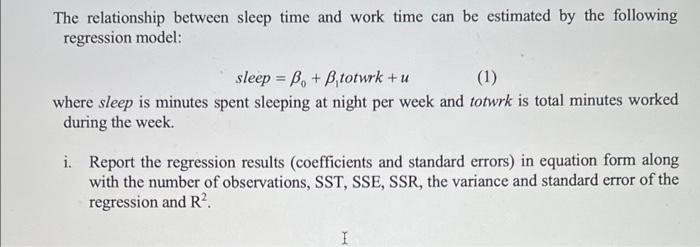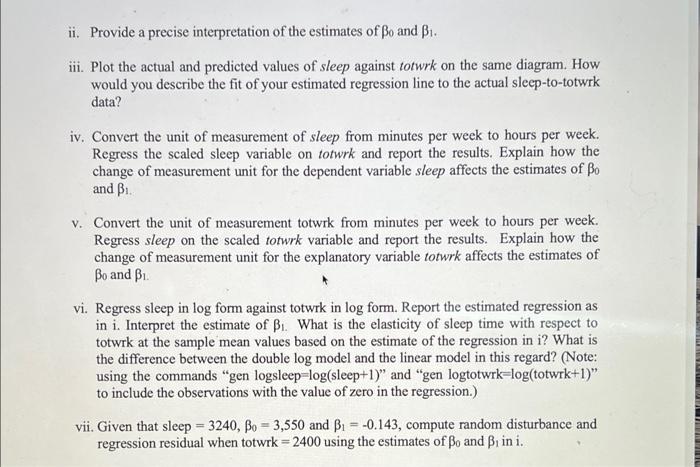The relationship between sleep time and work time can be estimated by the following regression model: sleep=0+1toturk+u where sleep is minutes spent sleeping at night per week and totwrk is total minutes worked during the week. i. Report the regression results (coefficients and standard errors) in equation form along with the number of observations, SST, SSE, SSR, the variance and standard error of the regression and R2. ii. Provide a precise interpretation of the estimates of 0 and 1. iii. Plot the actual and predicted values of sleep against totwrk on the same diagram. How would you describe the fit of your estimated regression line to the actual sleep-to-totwrk data? iv. Convert the unit of measurement of sleep from minutes per week to hours per week. Regress the scaled sleep variable on totwrk and report the results. Explain how the change of measurement unit for the dependent variable sleep affects the estimates of 0 and 1. v. Convert the unit of measurement totwrk from minutes per week to hours per week. Regress sleep on the scaled totwrk variable and report the results. Explain how the change of measurement unit for the explanatory variable totwrk affects the estimates of 0 and 1 vi. Regress sleep in log form against totwrk in log form. Report the estimated regression as in i. Interpret the estimate of 1. What is the elasticity of sleep time with respect to totwrk at the sample mean values based on the estimate of the regression in i? What is the difference between the double log model and the linear model in this regard? (Note: using the commands "gen logsleep =log( sleep +1) " and "gen logtotwrk=log(totwrk +1 )" to include the observations with the value of zero in the regression.) vii. Given that sleep =3240,0=3,550 and 1=0.143, compute random disturbance and regression residual when totwrk =2400 using the estimates of 0 and 1 in i. The relationship between sleep time and work time can be estimated by the following regression model: sleep=0+1toturk+u where sleep is minutes spent sleeping at night per week and totwrk is total minutes worked during the week. i. Report the regression results (coefficients and standard errors) in equation form along with the number of observations, SST, SSE, SSR, the variance and standard error of the regression and R2. ii. Provide a precise interpretation of the estimates of 0 and 1. iii. Plot the actual and predicted values of sleep against totwrk on the same diagram. How would you describe the fit of your estimated regression line to the actual sleep-to-totwrk data? iv. Convert the unit of measurement of sleep from minutes per week to hours per week. Regress the scaled sleep variable on totwrk and report the results. Explain how the change of measurement unit for the dependent variable sleep affects the estimates of 0 and 1. v. Convert the unit of measurement totwrk from minutes per week to hours per week. Regress sleep on the scaled totwrk variable and report the results. Explain how the change of measurement unit for the explanatory variable totwrk affects the estimates of 0 and 1 vi. Regress sleep in log form against totwrk in log form. Report the estimated regression as in i. Interpret the estimate of 1. What is the elasticity of sleep time with respect to totwrk at the sample mean values based on the estimate of the regression in i? What is the difference between the double log model and the linear model in this regard? (Note: using the commands "gen logsleep =log( sleep +1) " and "gen logtotwrk=log(totwrk +1 )" to include the observations with the value of zero in the regression.) vii. Given that sleep =3240,0=3,550 and 1=0.143, compute random disturbance and regression residual when totwrk =2400 using the estimates of 0 and 1 in








